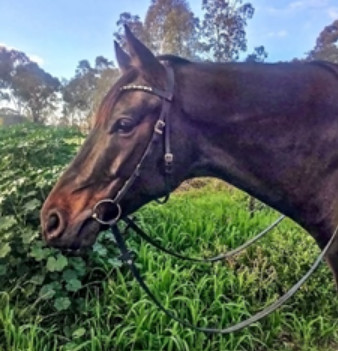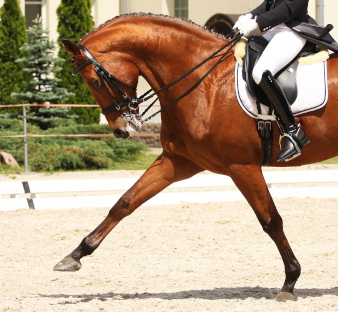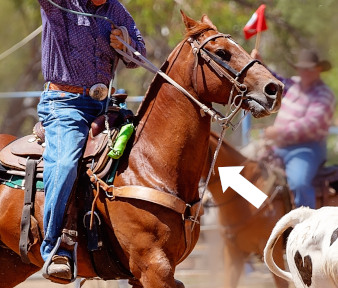Bits and tie-downs are types of equipment used on riding horses in Australia and internationally. The main welfare concerns associated with the use of bits and tie-downs is that they have the capacity to cause pain and discomfort to horses, and to restrict normal horse movement and function.
Bits
Bits are metal or metal and rubber devices that sit inside the horses’ mouth and are used to help control horses while they are being ridden. Bits allow the rider to deliver cues to the horse’s mouth through the reins, which are held in the rider’s hands.
Some bits have the potential to cause more discomfort to horses than others. Curb bits, for example, utilise a lever action to simultaneously apply pressure to the horse’s mouth, behind the ears, and under the chin (through a curb chain or strap). Snaffle bits, on the other hand, apply pressure mostly to the horse’s mouth, and are considered to be less severe.
However, there are a number of welfare concerns associated with the use of all bit types in riding horses:
- Bits have the potential to cause pain to sensitive tissues in the mouth and lips [1, 2]
- Bits have been associated with mouth, lip and jaw-bone lesions [3, 4]
- High rein pressure on the bit can lead to the restriction of head movement during riding, resulting in uncomfortable postures and/or movements as horses attempt to avoid the bit pressure [1]
- Rein pressure on bits can lead to horses carrying their heads with the chin tucked in excessively towards their chest (behind the vertical); this can cause airway restriction, making it difficult for horses to breathe easily [1, 5]
- The presence of the bit in the mouth can change air pressures inside the mouth and nose, leading to interference with breathing function [1, 5]
- Bit pain or pressure may be used to coerce horse performance and posture, even when more gentle training techniques are available


Tie-downs
Tie-downs are straps that connect the horse’s head, via a noseband, to the cinch or girth, which is the strap that holds the saddle on. They are generally used for high speed riding, such as polo, calf roping and barrel racing. The tie-down limits a horse’s upwards head movement. This is claimed to help horses balance and have something to brace against during high speed movements or direction changes.
There are a number of welfare concerns associated with use in riding horses:
- Tie-downs have the potential to cause pain; for example, if a horse throws their head up and the tie-down stops this movement suddenly, causing an impact and jerking of the head and neck
- Tie-downs restrict head and neck movement, which may cause uncomfortable postures or movements [6]
- Some riders use tie-downs to prevent a horse throwing their head up. This may mask underlying problems such as pain, discomfort or poor training techniques

What you can do
In order to avoid some of the welfare concerns associated with the use of bits, some riders now use bitless bridles. Many forms of bitless bridles are available. It is important to note that some bitless bridles, such as some of the ‘hackamore’ styles, can still exert significant pressure on the nose and chin of the horse, which can negatively impact horse welfare.
Careful selection of bitless bridles aiming to minimise poor horse welfare is recommended.
Generally speaking, the following are considered more severe, and best to avoid if possible:
- thin noseband straps [7]
- stiff or rawhide noseband straps
- a lever action function (e.g. the hackamore, where pressure applied to the chin and/or behind the ears through rein pressure)
Riders who feel that they need to use tie-downs and/or other restrictive riding gear due to their horses’ behaviour could consider seeking advice from a qualified horse trainer who uses gentle and positive training techniques. Many behaviour problems can be addressed through good training rather than restrictive gear.
Riders also need to develop an independent seat to minimise tension being applied to the reins in order to maintain balance. This can be achieved with the help of a qualified riding coach and structured practice on a suitably experienced and quiet horse.
Raising awareness of the impact of bits and tie-downs on horse welfare is also important, particularly for people who keep, ride or work with horses.
See also
References
[1] Mellor, DJ (2020) Mouth Pain in Horses: Physiological Foundations, Behavioural Indices, Welfare Implications, and a Suggested Solution. Animals, 10(4): p. 572.
[2] Cook WR, Kibler M (2019) Behavioural assessment of pain in 66 horses, with and without a bit. Equine Veterinary Education 31(10):551-560.
[3] Mata F et al (2015) A Cross-Sectional Epidemiological Study of Prevalence and Severity of Bit-Induced Oral Trauma in Polo Ponies and Race Horses. Journal of Applied Animal Welfare Science 18(3):259-268.
[4] Uldahl M, Clayton HM (2019) Lesions associated with the use of bits, nosebands, spurs and whips in Danish competition horses. Equine Veterinary Journal 51:154–162.
[5] Mellor DJ, Beausoleil NJ (2017) Equine Welfare during Exercise: An Evaluation of Breathing, Breathlessness and Bridles. Animals 7(41).
[6] McLean AN, McGreevy PD (2010) Horse-training techniques that may defy the principles of learning theory and compromise welfare. Journal of Veterinary Behavior 5:187-195. doi:10.1016/j.jveb.2010.04.002.
[7] Weller D et al (2020) The Reported Use of Nosebands in Racing and Equestrian Pursuits. Animals 10:776.
